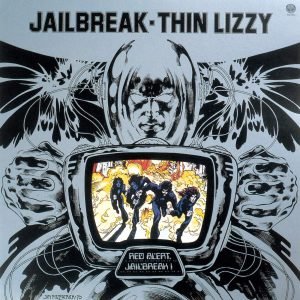Released in 1976, Jailbreak marked a turning point for Thin Lizzy. After years of modest commercial success and a rotating lineup, the band came into their own with this record. It was not a total reinvention, but rather a bold refinement of their growing sound. Building on the groundwork laid by earlier albums like Nightlife and Fighting, Jailbreak pushed their twin-guitar rock style into sharper focus. It also gave frontman Phil Lynott the space to fully showcase his talent as a songwriter and storyteller.
The album dropped at a time when hard rock was diversifying. Bands like Queen and Led Zeppelin were exploring grand, theatrical sounds. In contrast, Thin Lizzy carved out a more grounded identity—equal parts streetwise and poetic. Their blend of harmonized guitar riffs and vivid lyrics gave Jailbreak a clear voice, even as it stood among giants of the genre.
Behind the scenes, the stakes were high. The band faced pressure from their label to deliver a hit, which pushed them to craft songs that could reach a wider audience without losing their edge. This urgency led to a tighter production approach and more focused songwriting. The goal was to create something radio-friendly but still rooted in grit and emotion.
At the center of it all was Lynott. His vision for Jailbreak pulled from many sources—American rock, Irish folklore, and gritty urban life. Whether singing about outlaws or lonely romantics, he brought a sense of character to each track. The album walks a fine line between toughness and sensitivity, giving it a lasting appeal. It feels both of its time and ahead of it, setting the stage for Thin Lizzy’s most iconic moments.
Sonic Exploration

The production on Jailbreak strikes a careful balance between clarity and raw energy. Recorded at Ramport Studios in London and produced by John Alcock, the album avoids the overly polished sound that many rock records of the late ’70s began to adopt. Instead, it keeps a tight, punchy feel that complements the band’s gritty street-level storytelling. The mix allows the dual guitars of Scott Gorham and Brian Robertson to shine without overwhelming the rhythm section, while Lynott’s voice remains front and center, carrying both swagger and soul.
Musically, Jailbreak showcases Thin Lizzy’s signature twin-lead guitar approach, which was ahead of its time. Gorham and Robertson didn’t just double parts—they crafted intertwining lines that added depth and harmony to the arrangements. The solo work is often melodic rather than flashy, serving the song rather than overshadowing it. Lynott’s bass playing is understated but crucial, locking in tightly with Brian Downey’s dynamic drumming. Together, the band creates arrangements that feel deliberate and lean, with few wasted moments.
Genre-wise, the album is rooted in hard rock but touches on blues, soul, pop, and even folk influences. “Running Back” leans into softer, soul-tinged territory, while “Emerald” blends Irish folk scales with driving rock rhythms. These touches expand the album’s range without derailing its identity.
Lyrical Analysis

Jailbreak is driven by storytelling. At its core, the album explores themes of freedom, rebellion, loneliness, and identity—often through the lens of vivid character sketches and cinematic scenarios. Phil Lynott proves himself not just a frontman but a rock poet with a strong voice and a clear sense of narrative.
The title track “Jailbreak” sets the tone with a tale of escape and defiance. It’s more than a jailbreak in the literal sense—it’s a metaphor for breaking free from societal constraints, from boredom, and from a life that feels too small. This idea of living on the edge, choosing danger over comfort, runs throughout the record. “The Boys Are Back in Town” captures a different angle of this ethos: the excitement and unpredictability of youth returning to familiar streets, reclaiming a sense of belonging, even if only temporarily.
Other songs shift the focus inward. “Romeo and the Lonely Girl” and “Running Back” peel away the tough exterior and reveal themes of heartbreak and longing. Lynott’s lyrics in these tracks are tender, even vulnerable, without ever sounding sentimental. He writes with a conversational ease that makes his characters feel familiar. They could be friends, old flames, or parts of himself.
Lynott’s writing style leans toward the narrative and accessible. He rarely veers into abstraction. Instead, his strength lies in turning everyday language into something poetic. His use of plainspoken but rhythmic phrasing adds emotional punch to each track, allowing the listener to connect with the stories on a personal level.
Cohesion and Flow

One of Jailbreak’s key strengths lies in how well it moves from track to track. While it’s not a concept album in the strictest sense, there is a clear sense of progression—both musically and emotionally—that gives it a strong narrative arc. The album opens with the explosive title track, immediately establishing a mood of urgency and danger. It’s followed by “Angel from the Coast” and “Running Back,” which ease the pace and introduce more introspective tones. This contrast doesn’t feel abrupt, though. Instead, it mirrors the dual identity that runs throughout the album: the fighter and the dreamer, the outsider and the romantic.
Each side of the album (in its original vinyl format) feels carefully structured. Side A builds momentum and charisma, culminating in the anthemic “The Boys Are Back in Town.” Side B leans more into drama and emotional weight, with tracks like “Romeo and the Lonely Girl,” “Warriors,” and “Emerald” digging into darker and more introspective territory. The sequencing supports a kind of emotional journey—from swagger to solitude, from rebellion to reckoning.
Thematic Consistency
Thematic consistency is another area where Jailbreak excels. Across the album, Thin Lizzy stays true to a core set of ideas: freedom, identity, conflict, and emotional vulnerability. These themes aren’t confined to just the lyrics—they’re reinforced by the musical choices, from the sharp twin-guitar harmonies to the shifting dynamics between loud, riff-driven tracks and softer, more melodic moments. Even when the style leans toward pop (“Running Back”) or mythic hard rock (“Emerald”), the album doesn’t lose its voice.
That said, there are a few moments where the cohesion loosens. “Running Back,” with its keyboard-driven softness and pop sensibility, can feel slightly out of place compared to the rest of the album’s guitar-heavy grit. It offers a welcome change of pace, but it may jar listeners expecting a more consistent sonic punch. Still, its emotional honesty and strong melody help it earn its spot.
Standout Tracks and Moments
While Jailbreak holds together well as a full album, a few tracks rise above the rest—either for their artistic impact, their emotional pull, or their iconic status in Thin Lizzy’s catalog.
The Boys Are Back in Town
“The Boys Are Back in Town” is the most obvious standout, and with good reason. It’s not just the band’s biggest hit—it’s a masterclass in accessible rock songwriting. The twin guitars dance around each other with precision, while Phil Lynott delivers one of his most charismatic vocal performances. What sets this song apart is its ability to capture a fleeting moment in time—the buzz of reunion, the swagger of returning to familiar streets, and the undercurrent of danger beneath the surface. The line “If that chick don’t want to know, forget her” adds a casual bravado that feels authentic to the track’s barroom storytelling.
Jailbreak
The title track, “Jailbreak,” is another high point. It kicks off the album with cinematic flair, painting a vivid picture of escape and rebellion. The riff is lean but hard-hitting, and the chorus is anthemic without feeling forced. It sets the tone for the rest of the record—not just musically, but thematically. Lynott’s vocal delivery here strikes a balance between urgency and cool detachment, giving the character in the song a sense of mystery and depth.
Emerald
“Emerald” closes the album with a burst of intensity. It stands out for its use of Celtic-inspired melodies, especially in the guitar lines, which echo traditional Irish music but within a hard rock context. This track taps into Thin Lizzy’s roots in a way that feels both authentic and fresh. The interplay between Gorham and Robertson here is particularly tight, and the closing section—where the guitars break into a dueling rhythm—is one of the album’s most thrilling moments.
Romeo and the Lonely Girl
On the more emotional end of the spectrum, “Romeo and the Lonely Girl” deserves mention. It’s a relatively simple song in structure, but the lyrics and melody carry a heartfelt sadness that lingers. Lynott’s portrayal of a love gone wrong is understated yet affecting, and the song’s gentle pace provides a needed break from the album’s more aggressive moments.
Memorable Moments
A few specific moments also stand out across the record. The twin-guitar break in “Warriors” offers a gritty, almost warlike energy that matches the song’s title. Meanwhile, the keyboard motif in “Running Back” gives the track a soulful twist that breaks from the otherwise guitar-heavy aesthetic, showing the band’s willingness to experiment with mood and tone.
Another subtle but powerful moment comes in the chorus of “Fight or Fall.” It’s one of the quieter tracks on the album, but the harmony vocals and slow-build arrangement add emotional weight. It feels almost like a pause for reflection amidst the chaos.
Artistic Contribution and Innovation

Within the hard rock canon of the 1970s, Jailbreak holds a distinct place. It doesn’t redefine the genre in radical terms, but it refines it with precision, personality, and emotional nuance. At a time when hard rock was becoming increasingly grand and theatrical—thanks to acts like Queen, Aerosmith, and early metal pioneers—Thin Lizzy managed to ground the genre in street-level realism and lyrical storytelling. They weren’t interested in spectacle for its own sake. Instead, they focused on mood, character, and the push-pull of toughness and vulnerability.
One of the album’s most lasting contributions to rock music is its development of the dual-lead guitar sound. While other bands had experimented with harmonized guitar parts, Thin Lizzy made it a defining feature. Scott Gorham and Brian Robertson didn’t simply trade solos—they created a dialogue between their instruments. Their synchronized phrasing added depth and melody without sacrificing power, and that approach would later become a hallmark for bands like Iron Maiden, Judas Priest, and even some modern metal acts.
Innovation
Lyrically, Jailbreak also broke ground in its own subtle way. Phil Lynott’s writing avoided the typical posturing of many rock frontmen. He gave voice to outsiders, dreamers, and lovers without sounding affected or overly sentimental. His use of everyday language and vivid imagery brought a sense of realism to the album that was rare for the genre at the time. Whether he was writing about street gangs or broken hearts, Lynott approached each subject with empathy and grit.
Thematically, the album didn’t shy away from mixing myth with the mundane. “Emerald” draws from Irish history and legend, while “The Boys Are Back in Town” captures the energy of modern urban life. This blend of old and new, romantic and raw, gave the album a layered quality that many of its contemporaries lacked.
In terms of production, Jailbreak didn’t push technological boundaries, but it succeeded in achieving a sound that was both clean and powerful. The decision to keep the mix relatively straightforward—emphasizing the guitars, vocals, and rhythm section without heavy studio effects—helped preserve the immediacy of the performances. It’s an album that feels alive, not overly processed.
Closing Thoughts

Jailbreak stands as a landmark in Thin Lizzy’s career—a confident, emotionally resonant record that showcases the band’s strengths while leaving just enough room for critique. It’s an album built on tight musicianship, sharp storytelling, and a unique duality: rough-edged and polished, bold and introspective, rebellious yet reflective. At its best, it delivers songs that feel timeless—both sonically and emotionally.
Its greatest strength lies in its cohesion. The album flows naturally from one track to the next, balancing high-energy rockers with softer, more contemplative moments. Phil Lynott’s lyrics give the album its emotional core, while the band’s twin-guitar interplay provides a musical signature that still feels fresh decades later.
However, the album isn’t without its weaker points. “Running Back,” while catchy and melodically strong, feels slightly out of step with the rest of the record’s sonic palette. Similarly, not every track carries the same narrative weight or dynamic punch, which causes occasional dips in momentum.
Still, the impact of this album is hard to overstate. It elevated Thin Lizzy from a cult favorite to international recognition and influenced a generation of guitar-driven bands. It also gave rock a new kind of hero in Lynott—poetic, streetwise, and deeply human.
Official Rating: 8/10
Jailbreak earns a strong 8 for its blend of emotional depth, sharp songwriting, and musical innovation. It may not be flawless, but it remains one of the most enduring and soulful rock records of its era. For longtime fans and newcomers alike, it’s a powerful reminder of how much can be achieved when craft and character collide.
